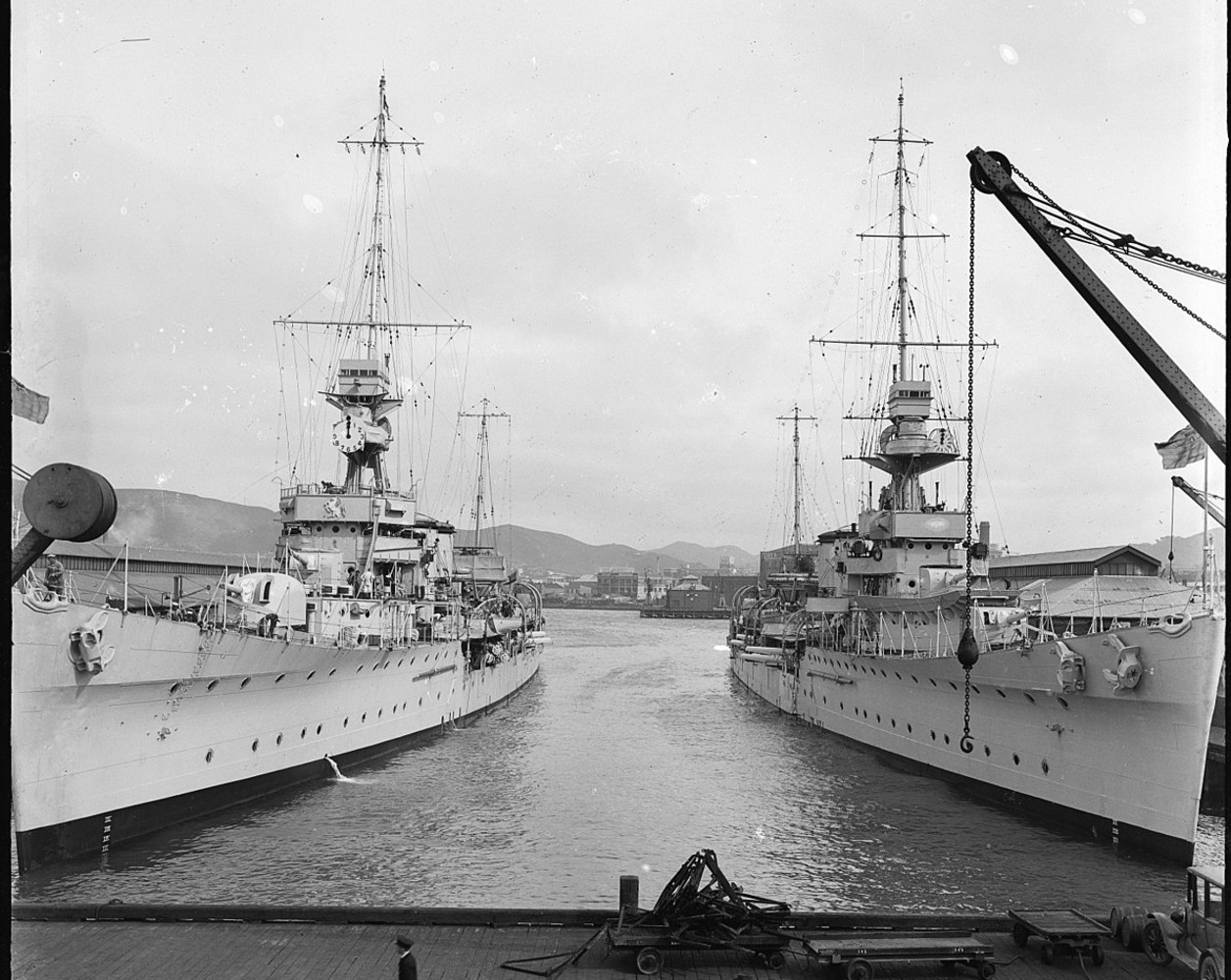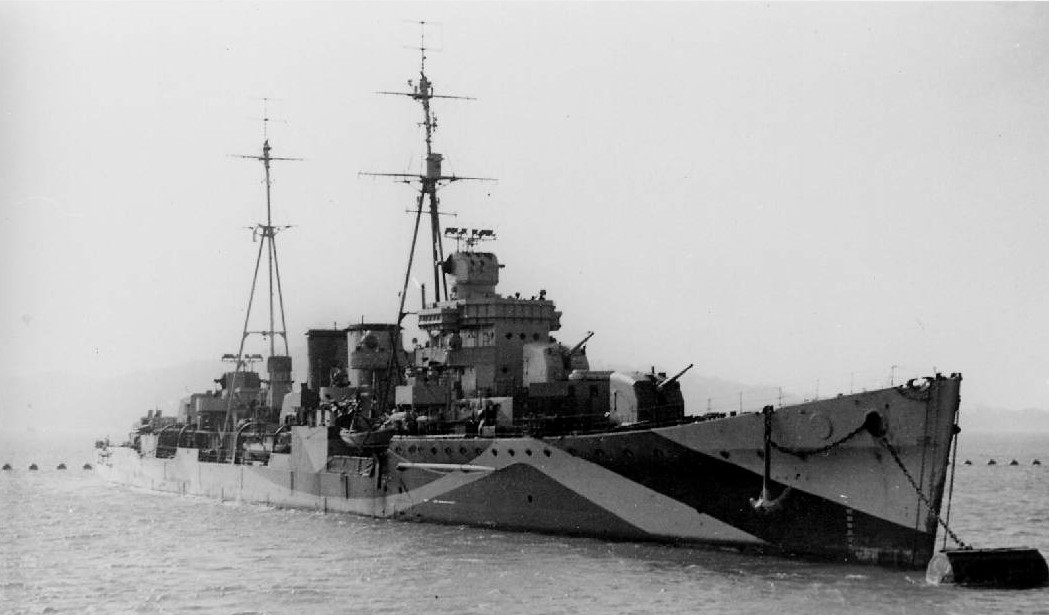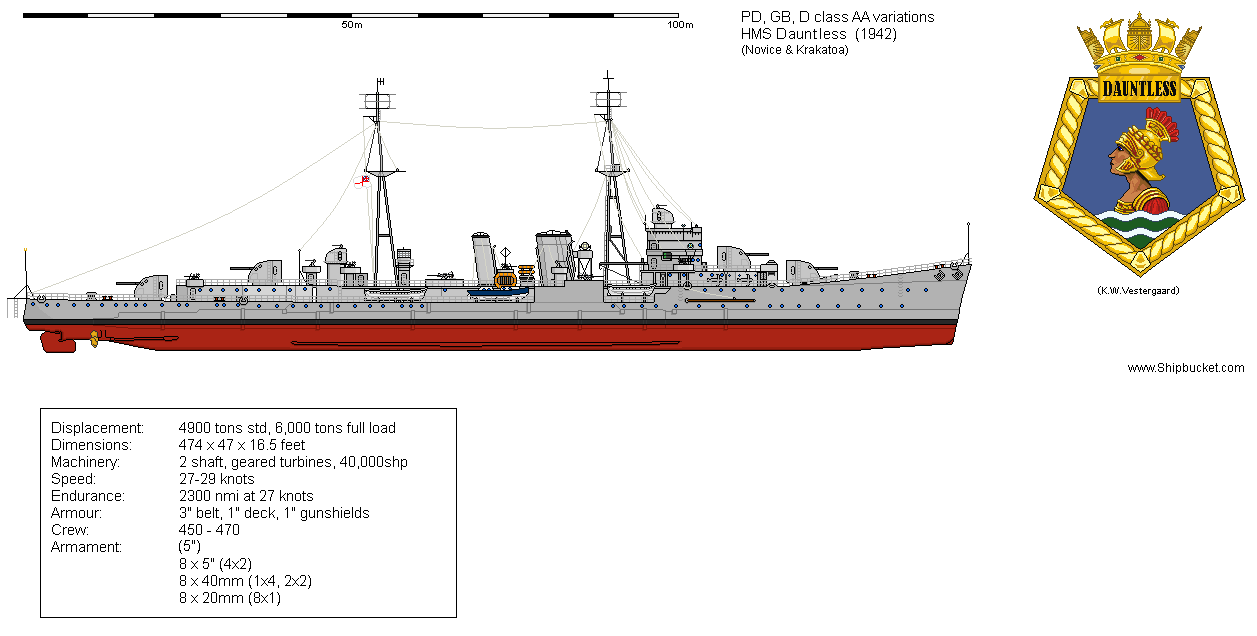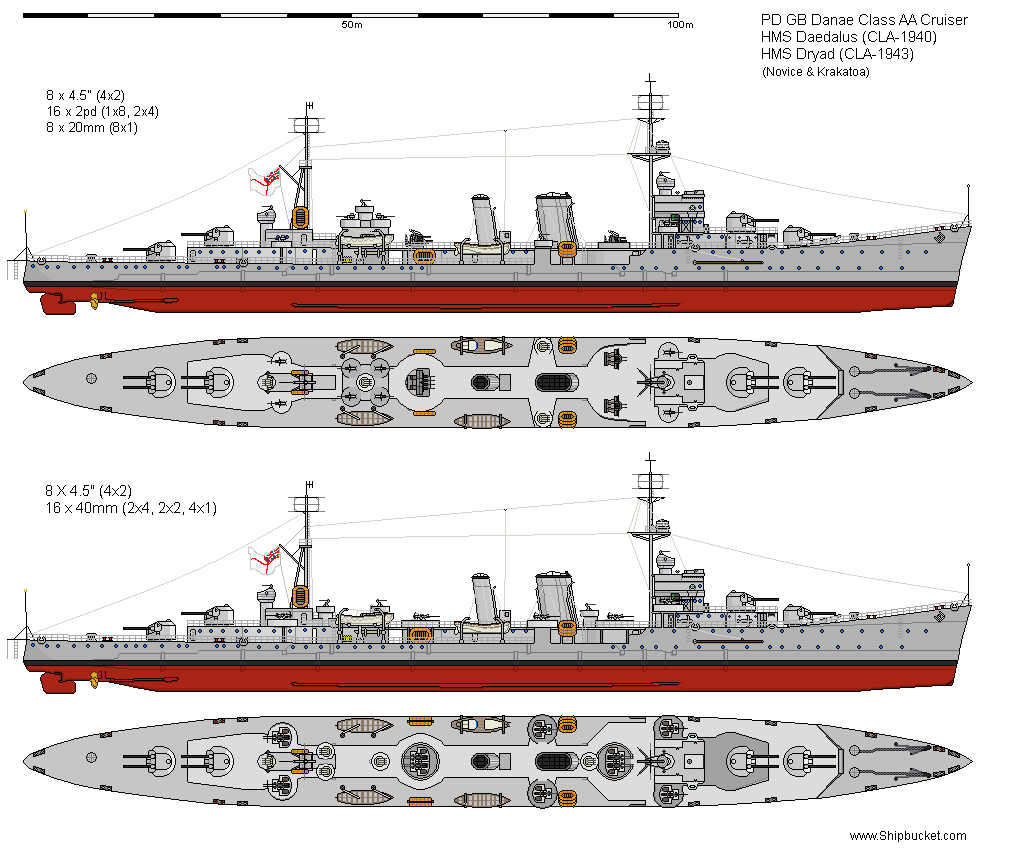'D' class
Cruisers (CL-1919-1925)
Back to Commonwealth Ships
List
The D class were the next step up from the C class. A bit more length and
breadth to fit an extra 6" to give an inline armament of six by 6" guns. The
same powerplant was fitted which produced the same 28-30 knot speed due to hull
hydrodynamics employed to smooth the hull.
The 'D' class is one of those classes with enough ships that I can experiment a
bit with various designs and layouts. Lots of the drawings did not always work
as you can see from the drawings below the statistics box. Full conversions with
turret guns would have required a complete remodelling of the interior to
provide the service lanes from magazine to turret. Cheaper to build a new ship.
This is why most of the conversions that worked on the C and D types were
converted around the single and twin 4" AA guns. The best fit being the one on
one swap of 6" singles for 4" twins. In real life the only D to be converted was
the Delhi which received its conversion under Lend / Lease agreement in the US,
from May to December, 1941 Delhi was
refitted as an anti-aircraft cruiser at the Brooklyn Navy Yard.
This introduced the Royal Navy to the 5"/38 dual purpose gun but more
importantly to the US Mk37 gun control system. The RN eventually was allowed to
build some under license and these were fitted to Vanguard some aircraft
carriers and Battle class destroyers. The RN caught up very quickly with this
technology replacing its old HACS units and 2pd radar predictors with updated
units from 1944-45 onwards. The introduction of the STAAG and other radar
onboard mountings also helped to phase out the old equipment.
_underway_off_the_Panama_canal_zone_on_31_October_1939.jpg)
First eight D class were completed to the standard shown below.


Above: HMS Diomede (left) fitted with experimental single 6" turret. HMS Dunedin
with standard armament. Both pictured at Wellington NZ in the late 1920's.

The final four that were to be completed post war, were completed to a different
design that laid out the 6" in three twin turrets as designed for the G3/N3
battleships.

HMS Daring was patrolling north of the Faroes Islands, in November 1939, in
support of two other members of the 10th cruiser squadron, HMS Rawalipindi and
HMS Chitral. HMS Rawalipindi made a sighting report of enemy surface ships and
minutes later upgraded its report to sighting the Scharnhorst and Gneisenau. The
Rawalipindi turned to fight even though it was hopelessly outgunned. The Daring
was only 20 minutes away and went to full speed to assist the Rawalipindi. When
the Daring arrived at the scene the Rawalipindi was still afloat but a complete
wreck. The Daring opened fire and drew the enemies fire off the Rawalipindi and
on to itself. The Daring was unlucky being hit by two 11" shells, from the first
salvoes, that wrecked the engine and boiler rooms, leaving the Daring stopped
but still firing its guns. The S & G continued to fire at what was now target
practice on the Daring and hits knocked out the two aft turrets and forward 4"
guns. The Daring fired its two triple torpedo tube sets at what was maximum
range but no hits were obtained. The S & G never even reported sighting
torpedoes. Further 11" hits wrecked the Daring and left it in a sinking
condition. The S & G went on their way and the HMS Chitral arrived and rescued
the survivors from the bitter waters. Many succumbed to exposure even after
being rescued from the icy seas. The Daring hit the Scharnhorst several times
and damaged one of the 5.9" single mountings and the adjacent 4.1 AA mounting
killing and wounding 27 crew. The other hits were on armoured positions and did
no damage. The Daring had been unlucky in taking the damage it did. It should
have been in a position to shadow the S & G with other members of the 10th
cruiser squadron and report their position reguarly
so that the main fleet out of Scapa Flow could intercept.
(what sort of happened in real life reports)
Sortieing from Scapa Flow on patrol on 23 November 1939, the Delhi and Daring
joined the cruisers Caledon, Cardiff, Newcastle and
the armed merchant cruisers Rawalpindi
and Chitral (10th Cruiser Squadron). During this patrol, Rawalpindi and
Daring encountered the German battleships Scharnhorst and Gneisenau,
and were sunk in a furious hour-long surface action. However, with Newcastle and Delhi shadowing
and the rapid approach of heavy units of the Home Fleet, Admiral
Marschall
withdrew his battleships into inclement weather, slipping his pursuers and
retreating to Wilhelmshaven.
Below is the standard conversion of the original D class cruisers to
anti-aircraft ships.

HMS Delhi after AA Cruiser conversion in the USA
1941.


The Dauntless like the Delhi went to the US for its rebuilding and was fitted
with twin 5"/38.

Where some of the smaller and handier C class cruisers were fitted with Asdic
and a few depth charges, the more unwieldly D class were never fitted out in
this way.
|
Displacement |
5,100 tons standard, 5,950 tons full load |
|
Length |
473 ft |
|
Breadth |
47 ft |
|
Draught |
16 ft |
|
Machinery |
twin shaft, Geared turbines, 40,000shp |
|
Speed |
28-30 knots |
|
Range |
4,500 miles at 15 knots
2,300 miles at 27 knots |
|
Armour |
3" side 1.5" deck |
|
Armament |
As built Original
6 x 6" (6x1)
3 x 4" AA (3x1)
2 x 2pd AA (2x1) |
As built Turrets
6 x 6" (3x2)
4 x 4" AA (4x1)
13 x 2pd AA (2x4, 5x1) |
AA Conversions
10 x 4" (5x2)
8 x 2pd (2x4)
16 x 0.5" mg (4x4) |
US Lend Lease Conversion
5 x 5" (5x1)
8 x 2pd (2x4)
12 x 20mm (4x2, 4x1) |
|
Torpedoes |
12 x 21" (4x3) |
12 x 21" (4x3) |
nil |
nil |
|
Complement |
400 |
390 |
410 |
415 |
|
Notes |
Original
Danae (1918)
Dauntless (1918)
Dragon (1918)
Delhi (1919)
Dunedin (1919)
torpedoed and sunk by the German submarine U-124 off Saint
Paul's Rock in
the South Atlantic 24 November 1941.
Durban (1921)
Despatch (1922) Sunk Malta Harbour as close escort of Illustrious
when it underwent emergency repairs at Malta after being bombed
January 1941.
Diomede (1922)
Turrets
Daedalus (1926)
Daring (1926) Sunk in action with Scharnhorst and Gneisenau as part
of 10th cruiser Squadron with HMS Rawalipindi
patrolling north of the Faroe Islands on
23 November 1939.
Desperate (1926)
Dryad (1927) |
Below, the RN wanted to extend the range of the D class ships and asked for a
design to be produced to cater for that.

Below are the speculative AA conversions with either 2pd pom poms or 40mm guns.
Both were armed with the light 4.5" turret.

Below: a thought I had to rearm the D's with 7.5" guns to match the heavy
cruiser ideas I was playing with at the time.
.PNG)
Below the 4.5/4.7" AA armed with twin turrets. It was felt the heavier twin
turrets would overload the hull.
.PNG)

Back to Commonwealth Ships
List
_underway_off_the_Panama_canal_zone_on_31_October_1939.jpg)



